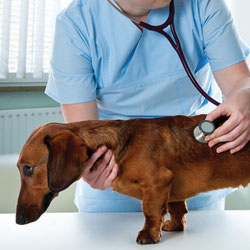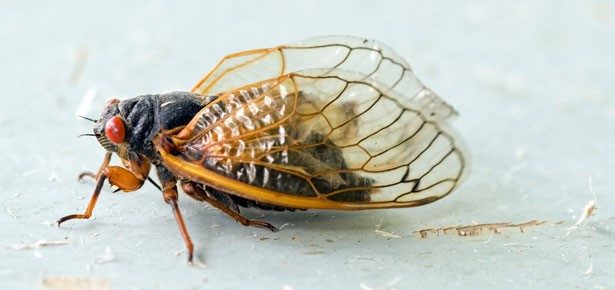

Managing Chronic Health Problems:
Change Your Dog’s Diet, Improve Her Health
Unfortunately, our dogs are prone to many of the same diseases we are. And, like us, many of these hit as our pets reach middle age, dratted aging! Indisputably, the diagnosis of a disease can be devastating, but take the reins—there are many things you can do to significantly support treatment. For one, a dog with chronic disease can greatly benefit from some diet changes. Altering the type and amount of some of the nutrients your dog receives can complement the treatments that your vet has prescribed. And taking control of your dog’s diet and health can help make a distressing diagnosis easier to live with. Just be sure to consult your veterinarian or veterinary nutritionist before implementing any changes, since dogs living with a chronic disease may have fragile health. It’s important to make sure any dietary changes are the right ones for your dog.
Cancer
The word “cancer” conjures near universal fear in people. Everyone has had a pet, family member, friend or acquaintance diagnosed with cancer. Two things to take comfort in: 1) Veterinary medical research has made great strides in the treatment of cancer in animals, and 2) You are not powerless: address what’s in your dog’s dinner. Many dogs undergoing cancer treatment greatly benefit from specialized nutrition that will support the body and starve the cancer.
In cancer diets, the calories should be coming from protein and fat and not from carbohydrates. Diets should contain 50 – 60 percent fat and 30 – 50 percent protein, with the remaining calories coming from soluble fiber, such as pectin, psyllium or pea fiber. In addition, the type of fat is important; it should be coming from fish oil or sustainable marine algae-derived omega-3’s, such as DHA Gold (dhagold.com) so be sure you are supplementing your dog’s diet with a high quality omega-3. Additionally, there is a whole arsenal of beneficial supplements that you should be adding to your dog’s dinner along with the omega-3’s, such as modified citrus pectin, which stimulates the immune system to kill cancer cells, and Turmeric/Curcumin, which has been shown to act in a number of ways to prevent the growth or spread of cancer cells for many different types of cancer. It works as an anti-inflammatory, as an antioxidant, and by encouraging cell death. Talk to your vet about dosage. Xue Yu Tang, a herbal supplement for blood stasis, is also used in cancer-fighting regimens, but talk to your vet about incorporating it into your dog’s diet as there can be some serious consequences to inappropriate use.
Veggies, especially the addition of cancer-fighting cruciferous vegetables such as cabbage and broccoli, should round out your dog’s dinner. Broccoli and cabbage are fine to feed raw occasionally, but if you are feeding them on a daily basis they should be cooked—cooking does not alter the antioxidant fighting ability—to prevent the naturally occurring glycosides in the vegetables from binding iodine in the diet. For more on canine cancer and diet, read “The Cancer Diet for Dogs: Fighting Back With Food” at moderndogmagazine.com/cancer-diet-dogs.
Heart Disease
The biggest thing you can do for dogs with heart conditions is to prevent them from being overweight. Reducing the weight of a dog who is packing some extr
There is also some very promising evidence suggesting that Hawthorn berry (Crataegus oxyacantha) is beneficial in treating heart disease, improving myocardial function and benefitting the heart muscle. Do discuss your interest in this supplement with your veterinarian, though, before starting with a Hawthorne berry supplement as a dog with heart disease may be on a number of veterinary prescribed medications which may interact with the Hawthorne berry, potentially creating problems.
Inflammatory Bowel Disease (IBD)
IBD is a complex and poorly understood condition with multiple contributing factors. Dogs with IBD are at risk for developing multiple food allergies so changing your dog’s food may be the best choice, however you may need to do multiple diet changes, trying out different protein sources to find the right one. During an acute episode of IBD, the diet should be 
Diabetes
Diabetes is a chronic disease which is caused by a deficiency of the hormone insulin. There are a number of risk factors for developing diabetes, including obesity, pancreatitis, hypothyroidism, and genetic predisposition. Like humans, dogs can get either Type I or Type II diabetes. Type I diabetes is caused by a destruction of the insulin producing cells in the pancreas and is the type with the greatest incidence in dogs. Type II diabetes is less common in dogs, and is caused by impaired insulin secretion or insulin resistance. While both types can benefit from dietary changes, Type I cannot be managed by diet alone and dogs with this type will need insulin replacement therapy.
The goal with dietary management is to regulate the dog’s blood glucose levels. Once a dietary approach is chosen, dogs should stay on the same food and feeding schedule so that nutrients are provided consistently. Semi-moist foods and treats should be avoided as these typically have a lot of sugar (simple carbohydrates) in them which are quickly absorbed and cause a spike in glucose in the blood, something a diabetic dog doesn’t have the insulin capacity to deal with. There is no need to restrict protein intake unless the dog also has another condition, like kidney disease, requiring it; overweight dogs may need to have a fat-restricted diet to help them lose weight. But overall, it is carbohydrates that have the greatest impact on blood glucose levels, so take a close look at the carbs your dog is consuming. The diabetic diet should be high in complex carbohydrates (comprising 40 percent or more of total calories) and have moderate fibre levels. Complex carbohydrates require more digestion than simple carbohydrates and thus are absorbed into the blood stream more slowly. This provides a slow, steady input of glucose into the blood, as opposed to the quick burst that simple carbohydrates deliver. Look for a food that contains whole grain starches, like barley or sorgum.
The timing of meals is also important. Meal scheduling will depend on the insulin schedule used, but in general four to five smaller meals should be provided. The first meal of the day should be offered before the insulin injection so that if the dog refuses to eat, the insulin can be withheld. Meals times should remain as consistent as possible and extra foods like treats and chews need to be figured into the schedule. Diabetic dogs can still have treats, but look for ones that are mostly complex carbohydrates and higher in fibre or protein. Try items like dehydrated chicken strips or sweet potato chews. Steer clear of the regular dog biscuits and avoid any of the semi-moist treats.
Also try:
CHROMIUM. Research has found chromium to be very beneficial in improving the cells’ uptake of insulin. FENUGREEK SEEDS. Fenugreek seeds, taken as a tea, can help lower blood sugar. CINNAMON. Cinnamon extract has strong antioxidant properties and can help maintain healthy blood sugar.
Allergies, Ear Infections & Hot Spots
The skin is your dog’s largest organ and therefore a great indicator of your dog’s overall health. Skin health can be affected by many different nutrient
Start with a well balanced diet that provides optimal nutrition while avoiding the trigger foods. If you haven’t yet figured out which foods are the triggers, undertaking an elimination diet in which you rule out one ingredient (wheat; a particular protein source) at a time over a period of months will be necessary.
Choosing a diet that has a high quality protein will ensure that your dog has the building blocks needed for maintenance of healthy skin. Essential fatty acids, like omega-3 fatty acids, are also important for the skin. Omega-3’s play two roles: they act as an anti-inflammatory, helping to reduce any inflammation responses due to allergies, as well as form part of the cell membrane, playing a key role in cell health.
moderndogmagazine.com/foodallergies101
Arthritis
Arthritis is inflammation in the joint. There are a number of types, but the most common is osteoarthritis, which is a progressive breakdown of the cartilage in the joint causing pain, which can lead to loss of mobility and weight gain. A pain management plan should be combined with dietary management, a key component of which is keeping your dog at a healthy weight—a fit dog carries less weight and subsequently puts less stress on their joints. Since arthritis is an inflammatory disease, omega-3s are a wonder supplement because they reduce inflammation. There are some joint supplements available that contain high omega-3 fatty acids but you can also supplement your dog’s diet with fish oil capsules or marine-algae derived omega-3 capsules like DHA Gold. Glucosamine and chondroitin were thought to be very good supplements for relieving arthritis pain and increasing mobility, however, over the test of time, research has suggested that they are very poorly bioavailable to the body. As a result, these are better used as injectable rather than dietary supplements. The injectable products available have been proven to be very beneficial in increasing mobility in dogs, so ask your vet for further information. Finally, green lipped mussel (GLM) is a natural product that has been clinically proven to improve mobility in dogs. GLM contains omega-3 fatty acids and is thought to contain other antioxidants as well as glucosamine. The dose of GLM should be 0.3 percent of your dog’s normal food (0.3g GLM/cup of dog food).
Dental Health
Dental disease, comprising gum disease (gingivitis), periodontal disease, and bad breath, is incredibly common in dogs. By four years of age, 80 percent of dogs will have some form of dental disease.
Gingivitis is the inflammation of the gums caused by an over growth of bacteria. If left untreated, it can lead to periodontal disease, the inflammatory disease that affects the periodontal ligaments and alveolar bone. While gingivitis can be treated, periodontal disease cannot and often results in the loss of affected teeth. This is why your vet stresses the importance of brushing your dog’s teeth!
Dogs consuming soft or tinned foods often have a higher incidence of gingivitis than dogs eating a dry diet, so giving your dog something to chew on can improve his dental health. Rawhide chews and hard bones has been associated with reduced plaque formation.
Some raw bones may be too hard for some dogs and can result in damage to the teeth. Cooked bones such as chicken or rib bones should not be given to dogs as these can splinter and pose a choking or gut perforation risk.
You can also encourage chewing by giving your dog a raw carrot or piece of sweet potato to chew on or a “dental” toy, a textured toy designed to maximize contact with the teeth. Make the dental toy more tempting by putting a small amount of peanut butter or spreadable cheese on it.
Also try adding a bit of parsley to your dog’s dinner (1/2 teaspoon to 1 tablespoon depending on the size of your dog). Parsley has long been known for its breath sweetening properties and helps make those doggie kisses more tolerable. (* Do not give parsley to pregnant dogs or dogs with kidney problems. Also, make sure you don't use spring parsley, which can be toxic in large amounts!)
Many people claim that their dog’s teeth and breath improve dramatically when they switch from commercial kibble to a home-prepared diet. This may be due to an improvement in the quality of the diet, increased chewing for dogs fed whole bones, or the presence of fresh ingredients. If you’re not feeding a home-prepared diet, try adding fresh fruits and veggies to your dog’s dinner. For suggestions, see People Foods For Dogs:
moderndogmagazine.com/10-people-foods-dogs
moderndogmagazine.com/10-human-foods-share
moderndogmagazine.com/10-more-people-foods-dogs
Water additives such as Healthy Mouth can also improve your dog’s dental health. Healthy Mouth is a mixture of natural ingredients that work to reduce the amount of bacteria in your dog’s mouth, thereby reducing plaque formation. It has been clinically proven to work in dogs, cats and horses and it is available from your veterinarian. If your dog doesn’t love the taste initially, use a slightly diluted form of the product and then work your way up to full strength over the course of a week.
Diet certainly plays an important role in managing chronic health problems. As always, it’s important to work with your veterinarian on these issues as some dietary changes may have a big impact on the treatment protocol for your dog. A good diet that meets your dog’s unique health needs can help to prevent chronic diseases from progressing or recurring. And knowing that you are doing everything you can to help meet their health needs means one less thing to worry about and more time to spend out for a walk or snuggled on the couch.
Join the newsletter and never miss out on dog content again!
"*" indicates required fields
By clicking the arrow, you agree to our web Terms of Use and Privacy & Cookie Policy. Easy unsubscribe links are provided in every email.





